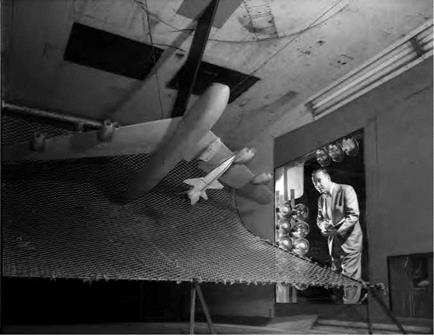Avoiding Catastrophe: Vehicle/Store Separation
One of the more complex and challenging areas in aerospace technology is the prediction of paths of aircraft components following the release of items such as external stores, canopies, crew modules, or vehicles dropped from mother ships. Aerodynamic interference phenomena between vehicles can cause major safety-of-flight issues, resulting in catastrophic impact of the components with the airplane. Unexpected pressures and shock waves can dramatically change the expected trajectory of stores. Conventional wind tunnel tests used to obtain aerodynamic inputs for calculations of separation trajectories must cover a wide range of test parameters, and the requirement for dynamic aerodynamic information further complicates the task. Measurement of aerodynamic pressures, forces, and moments on vehicles in proximity to one another in wind tunnels is a highly challenging technical procedure. The use of dynamically scaled free-flight models can quickly provide a qualitative indication of separation dynamics, thereby providing guidance for wind tunnel test planning and early identification of potentially critical flight conditions.
Separation testing for military aircraft components using dynamic models at Langley evolved into a specialty at the Langley 300-mph 7- by 10-Foot Tunnel, where subsonic separation studies included assessments of the trajectories taken by released cockpit capsules, stores, and canopies. In addition, bomb releases were simulated for several bomb – bay configurations, and the trajectories of model rockets fired from the wingtips of models were also evaluated. As requests for specific separation studies mounted, the staff rapidly accumulated unique expertise in
testing techniques for separation clearance.[500] One of the more important separation studies conducted in the Langley tunnel was an assessment of the launch dynamics of the X-15/B-52 combination for launches of the X-15. Prior to the X-15, launches of research aircraft from carrier aircraft had only been made from the fuselage centerline location of the mother ship. In view of the asymmetrical location of the X-15 under the right wing of the B-52, concern arose as to the aerodynamic loads encountered during separation and the safety of the launching procedure. Separation studies were therefore conducted in the Langley 300-mph 7- by 10-Foot Tunnel and the Langley High-Speed 7- by 10-Foot Tunnel.[501]
Detailed measurements of the aerodynamic loads on the X-15 in proximity to the B-52 under its right wing were made during conventional force tests in the high-speed tunnel, while the trajectory of a dynamically scaled X-15 model was observed during a separate investigation in the low-speed tunnel. The test set up for the low-speed drop tests used a dynamically scaled X-15 model under the left wing of the B-52 model to accommodate viewing stations in the tunnel. Initial trim settings for the X-15 were determined to avoid contact with the B-52, and the drop tests showed that the resulting trajectory motions provided adequate clearance for all conditions investigated.
During successful subsonic separation events, a bomb or external store is released, and gravity typically pulls it away safely. At supersonic speeds, however, aerodynamic forces are appreciably higher relative to the store weight, shock waves may cause unexpected pressures that severely influence the store trajectory or bomb guidance system, and aerodynamic interference effects may cause catastrophic collisions after launch. Under some conditions, bombs released from within a fuselage bomb bay at supersonic speeds have encountered adverse flow fields, to the extent that the bombs have reentered the bomb bay. In the early 1950s, the NACA advisory committees strongly recommended that focused efforts be initiated by the Agency in store separation, especially for supersonic flight conditions. Researchers within Langley’s Pilotless Aircraft Research Division used their Preflight Jet facility at Wallops to conduct research on supersonic separation characteristics for several
|
Langley researcher William J. Alford, Jr., observes a free-flight drop model of the X-15 research aircraft as it undergoes separation testing beneath a B-52 model in a Langley tunnel. NASA. |
high-priority military programs.[502] The Preflight Jet facility was designed to check out ramjet engines prior to rocket launches, consisting of a "blow down’-type tunnel powered by compressed air exhausted through a supersonic nozzle. Test Mach number capability was from 1.4 to 2.25. With an open throat and no danger to a downstream facility drive system, the facility proved to be ideal for dynamic studies of bombs or stores following supersonic releases.
One of the more crucial tests conducted in the Wallops Preflight Jet facility was support for the development of the Republic F-105 fighter – bomber, which was specifically designed with forcible ejection of bombs from within the bomb bay to avoid the issues associated with external releases at supersonic speeds. For the test program, a half-fuselage model (with bomb bay) was mounted to the top of the nozzle, and the ejection sequence included extension of folding fins on the store after release. A piston and rod assembly from the open bomb bay forcefully ejected the
store, and high-speed photography documented the motion of the store and its trajectory. The F-105 program expanded to include numerous specific and generic bomb and store shapes requiring almost 2 years of tests in the facility. Numerous generic and specific aircraft separation studies in the Preflight Jet facility from 1954 to 1959 included F-105 pilot escape, F-104 wing drop-tank separations, F-106 store releases from an internal bomb bay, and B-58 pod drops.











